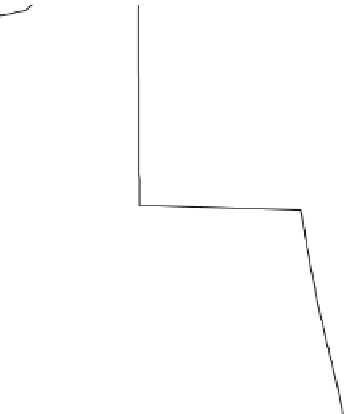Environmental Engineering Reference
In-Depth Information
0
0
-1
-1
-2
-2
-3
-3
-4
-4
-4
-3
-2
-1
0
0
0.1
0.2
0.3
0.4
0.5
pressure head, h (m)
water content,
θ
Fig. 18.11
Numerically calculated pressure head (
left
) and water content (
right
) versus depth for
infiltration in a two-layer (sand over silt) soil profile, assuming a flux
q
of 2
10
−
6
m/s. The solid
×
line is for
t
=
0, while distributions at other times (1, 5, 10, 20, 30, 40, 50, 60, 70 h) are indicated
by dashes of decreasing length
in both layers, except in a fairly thin zone near the interface. The consequence of
having several soil layers on sampling density is obvious from Fig.
18.11
:very
few samples are required within each homogeneous layer, but the zone above the
interface requires a more dense sampling scenario.
18.3 Contaminant Transport
Similarly as Eq. (
18.8
) for water flow, mathematical formulations for contaminant
transport are based on a mass balance equation of the form:
∂
C
T
∂
=−
∂
J
T
∂
z
−
φ
(18.23)
t
where
C
T
is the total concentration of contaminant in all forms [ML
−
3
],
J
T
is
the total contaminant mass flux density (mass flux per unit area per unit time)
[ML
−
2
T
−
1
], and
is the rate of change of mass per unit volume by reactions or
other sources (negative) or sinks (positive) such as plant uptake [ML
−
3
T
−
1
].
In its most general interpretation, (Eq. (
18.23
)) allows the contaminant to exist
in all three phases of the soil (i.e., soil gas, liquid phase, and solid phase). The
φ













































































































































































































































































































































































Search WWH ::

Custom Search